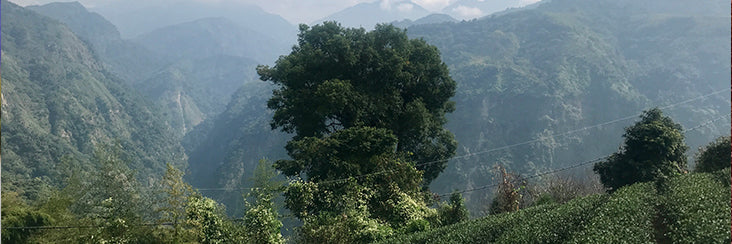
Red Oolong Tea | Eco-Cha Tea Club

Above is the view from the mountain where this month's batch of tea grew. It's the highest spot in the small tea growing area of Shan Ping Ding in Zhushan Township in Nantou County. The area was initially developed with the onset of Jin Xuan, or Tai Cha #12 over 30 years ago. But these plots of tea are at a high enough elevation to warrant Qing Xin Oolong cultivation. And this micro-climate of a deep valley offers more conducive growing conditions than most farms at 800m elevation.

Above is the actual plot of Qing Xin Oolong tea that was harvested in September and processed to become a Red Oolong. In Taiwan at least, this is a new name for an old style of tea making that 50 years ago was simply called "Oolong Tea". Red Oolong (or Hong Oolong) has been promoted by the Tea Research and Extension Station to be produced in south-eastern Taiwan to offer this area a differentiation value in the style of tea they produce. It has been successful in popularizing the name, but in our experience, the commonly available Red Oolong is almost synonymous with Small Leaf Black Tea. It looks and tastes like the leaves are fully oxidized.
This is what inspired us to share this batch of tea that was produced in Nantou County. We consider this batch of tea to be properly named Red Oolong, simply because the leaves are obviously only partially oxidized. The flavor of the tea has aspects of a Black Tea character while maintaining the fragrant, aromatic complexity of an Oolong.

The initial stages are basically the same as Oolong tea processing — with solar withering, indoor withering, and shuffling, but there is one step that makes it definitively a Red Oolong. The leaves are delicately bruised using the primary rolling machine BEFORE the tumble heating/cease oxidation step. We've been told by traditional Oolong tea makers that this was common practice before the modern mechanization of tea processing — in other words, when everything was done by hand (and foot!).

All these photos were just recently taken — on the day/night that Mr. Zhang harvested and processed his winter crop from the same plot of tea. We were introduced by a mutual friend who is apprenticing with Mr. Zhang. Our friend who introduced us has a PhD in soil science and inherited his family's organic tea farm about 5 years ago.

He has been ardently learning the science of tea making ever since, and we've repeatedly heard him comment that he was very lucky to meet Mr. Zhang. We can see why he feels this way. Mr. Zhang manages his own small farm and does the processing himself, with the help of his younger generation tea farmer friends, who are committed to learning from him. We've watched him making tea twice in the last month, and it has been very educational.
He is employing pre-modern tea making techniques while being completely competent in each step of the modern tea making process — coming from of 30 years of hands on experience. He has a meticulous streak in him that sets his methods apart from the norm. We feel that this batch of Red Oolong represents his skill and dedication. Mr. Zhang brewed it for us on our first visit to his home. He also gifted us with a sample of it when we left. We knew we needed to share it with the tea club after brewing it again at home.

Above is a shot looking out over the valley from the plot of tea that produced this batch of Red Oolong. We look forward to hearing about your experiences of this batch of tea that represents a living embodiment of the local lineage of traditional Oolong tea making.
LET US KNOW!
We really want to know what you think! Leave your impressions or questions in the comment section below!
SUBSCRIBE!
If you enjoyed this post and would like to hear more about the specialty tea industry here in Taiwan, follow us on YouTube, Facebook, and Instagram and please subscribe to our newsletter. Subscribe now and get $5 off your first order!

